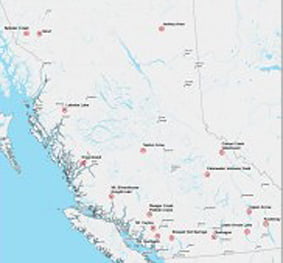
False Creek Energy Centre Low Carbon Expansion

Project Highlights
Recipient of 2025 Award of Merit by ACEC-BC for Energy & Industry
Maximizing Renewable Energy Through Innovative Sewage Heat Recovery
The City of Vancouver’s Neighbourhood Energy Utility (NEU) is committed to achieving 100% low-carbon energy by 2030, reducing building-related greenhouse gas emissions across the city. At the core of this transformation is the False Creek Energy Centre (FCEC)—a key component of Vancouver’s District Energy System (DES), providing sustainable heat to 47 buildings covering over 7 million square feet in the downtown core.
Before this expansion, FCEC relied on a combination of heat pumps (40%) and renewable natural gas (30%) to meet its low-carbon energy targets. To further reduce natural gas consumption, the City launched a major low-carbon expansion project, adding 6.6 MW of sewage heat recovery heat pumps, tripling the facility’s heat pump capacity. This transformed FCEC into North America’s largest sewage heat recovery facility, significantly increasing the contribution of heat pumps to an estimated 80% of the annual energy supply.
By leveraging innovative engineering solutions and maximizing the use of existing infrastructure, the expansion avoided the need for additional energy centers or costly renewable gas purchases. The successful execution of this project strengthens Vancouver’s leadership in sustainable energy solutions and provides a model for other municipalities looking to implement similar carbon reduction strategies.
Engineering & Design Approach
KWL played a critical role in maximizing low-carbon energy output within the existing FCEC facility by developing progressive engineering solutions focused on efficiency, spatial optimization, and technological advancements.
Advanced 3D Modelling for Space Optimization
- KWL conducted a full 3D scan of the facility and designed the plant in 3D to avoid conflicts and ensure all equipment remained accessible for maintenance and operation.
- The spatial constraints required creative equipment placement, allowing for the installation of two 3.3 MW heat pumps in a space originally designed for one—a solution that significantly increased capacity without infrastructure expansion.
- The 3D modeling efforts streamlined construction, reducing contractor questions, enabling prefabrication of piping sections, and allowing work to proceed while maintaining plant operations.
Direct Connection to the Sewage Forcemain
- Instead of relying on sewage from the existing wet well, KWL redesigned the intake system to connect directly to a nearby forcemain, where higher temperatures enhanced heat pump efficiency and capacity.
- This required a new high-pressure, high-flow filtration solution—a first-of-its-kind innovation.
Engineering the Next-Generation Autostrainer
- Traditional screening methods could not handle the high-pressure flow from the forcemain, so KWL collaborated with SHARC Energy Systems to design a custom high-pressure autostrainer.
- This eliminated the need for operators to enter the hazardous wet well, improving safety and setting a new standard for future sewage heat recovery projects.
- The upgraded SHARC autostrainer technology is now planned for deployment in multiple sewage heat recovery projects across the region.
Optimized Control Systems for Heat Pump Integration
- KWL reengineered FCEC’s control systems to fully automate operations and equipment dispatch, ensuring efficient operation and minimizing unnecessary cycling.
- Collaboration with the City of Vancouver’s sewer operations team helped fine-tune pump controls at the upstream pump station, ensuring optimal flow for the heat pumps without impacting overall sewer system performance.
Electrical Capacity Expansion
- With heat pump capacity tripling, the facility’s electrical system required a significant upgrade.
- KWL designed and coordinated the installation of a new transformer and MCCs, requiring additional space outside the main electrical room while maintaining seamless integration with the existing systems.
Project Outcomes & Impact
The False Creek Energy Centre Low-Carbon Expansion successfully tripled sewage heat recovery capacity—boosting anticipated low-carbon energy supply from 40% to 80%, without relying on additional renewable natural gas purchases or new energy centers.
- Largest sewage heat recovery facility in North America, setting a benchmark for sustainable urban energy systems.
- Exceeds Vancouver’s low-carbon energy targets, advancing the City’s goal of 100% low-carbon energy by 2030.
- Cost-effective carbon reduction strategy, providing a scalable model for other municipalities.
- Innovative technology development, with the SHARC autostrainer now being deployed in multiple regional projects.
- Minimal disruption to existing operations, ensuring continuous service to 47 buildings during construction.
The FCEC expansion represents a major leap forward in sewage heat recovery innovation, low-carbon energy development, and urban sustainability—cementing Vancouver’s leadership in climate-conscious infrastructure.
Key Contact(s)
Abby Dacho Project Engineer
Mohammed Sheha Project Engineer
Ayman Fahmy Energy Sector Leader
Amber MacNeill Mechanical Engineer










